|
|---|
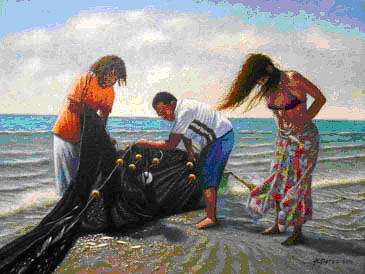 |
 |
Costa Rican Scenes by Tico Artist Hernan Peréz Peréz on Exhibit at the Hidden Garden Art Gallery Near Liberia: Left: "Dos pescadores y turista" (Two Fishermen and Tourist) and Right: "Cristina y su mundo" (Christine and Her World) - Now That's the Way to Enjoy the Beach |
|
Broken News
Cédula Update
Some of our Gentle Readers may have been following our hero's plight as he pursued a legal status of residency here. The process was initiated in May of 2009, about 8 months after GG moved here (See Cédula).
An intermediary suggested by a friend was employed to spearhead the process, a lady that runs an ex-pat immigration legal service in San José . She turned out to be less than ethical, even getting arrested for corruption at one point along side her contact in Immigration who was arrested at the same time. The associate was held for trial while my intermediary was released after a few hours.
The problems with my lady came to a head in August 2011 when I found that out my application had been formally rejected by Costa Rica Migración because of a failure to supply all the required documents. I had given m'lady everything required several months earlier but at our last meeting she could not say for sure where they were, claiming that the Costa Rican consulate in Washington always sends the documents directly back to Migración, a procedure that the Department denied they do.
I then received an urgent email from the babe telling me I had to get out of the country within three days! After a fast and furious trip to San José (sans weapons) to meet with the intermediary I went to Migración with a Tico friend to determine the facts (see the October 2011 article Gullible Travels). Lotsa lies had been told. I then suspended the intermediary's services (that's political correctness meaning I fired her butt) and made a quick visit to the Panama border to renew my visa.
 |
|---|
GG's Cédula - The Blurring is Not My Camera but Courtesy of Immigration - Would You Buy a Used Car From This Guy? |
After rejecting my application, The Immigration department sealed the folder meaning I had to start from scratch and gather all new documents, photos, fingerprints and several other requirements to apply a second time. I then set out to learn in detail about the process, spending almost three days on the internet assembling the cast of characters, addresses, fee payment methods and other requirements to get it all done. I enlisted a friend in the U.S. to forward requests for documents and certifications of same. With return envelopes it took a total of 9 envelopes.
On this second try I started gathering info in late August 2011 and I had everything assembled by the end of October. That was two months, a rather startling moment when I realized I had worked with the intermediary for two years and my documents at that time had not yet been accounted for by her. I submitted the new documents to the Immigration department the first week in November last year and was told to check back in 90 days, i.e., early February. In mid February, at 98 days, it wasn't ready.
We subsequently learned there had been a department wide slowdown in Migración that added extra time to the processing.of my application but on Thursday June 14, I was finally informed that my application had been approved and on Monday, June 18, I had my photo taken at Migración and received the cédula with the bad passport photo (above). It's written as a temporary residence permit renewable in two years.
That was seven months from the time of document submission to receipt of the cédula. It took a total of nearly 20 items including various fee deposits, photos, an application, fingerprints, a couple of document translations etc., but once all the items had been submitted, it was a rather smooth process.
Live and learn, amigos.
¡Pura Vida!.
A recent headline in the local English press opened my eyes when it said: "Wealthy U.S. Citizens Dumping Passports to Avoid tax." The article went on to say that some 3,800 high net-worth individuals renounced their U.S. Passports in 2011 and that number is expected to rise to over 8,000 in 2012.
 |
|---|
Reasons? Simply to avoid taxes. They're expecting continuous increases in tax rates on their income from the expiration of the Bush-tax cuts at year end and another proposed 55% tax rate for high income individuals.
These people (the rich), by virtue of their wealth, have freedom to live and conduct their businesses from anywhere in the world. And where are these malcontents going? Reported in the same article as favorite destinations: Costa Rica, Cayman Islands, Australia, Norway, Antigua, Guernsey and Singapore.
That latter country, Singapore, is no surprise as it ranks number one in the World Bank Ease of Doing Business Index, three positions ahead of the old number one, the U.S. of A. (see Rank Ranking).
But even renouncing your citizenship is costly and doing so supposedly subjects one to a U.S. 15% "exit tax" on net worth. I strongly suspect that much of this is still avoided by judicious transfer of assets and income over some period of time prior to renunciation.
For GG, of course, this current imbroglio over taxes is not a problem. I have successfully avoided the accumulation of excessive assets and high taxable gross income for over two decades now and I have no plans to change an unblemished record.
¡Solo Bueno!
More China Ties
We just passed the 5th anniversary of the breaking of diplomatic relations by Costa Rica with Taiwan in lieu of the Tico recognition of the People's Republic of China (PRC) as the "Real China". The Tico government was convinced to change allegiances with the promise of financial aid in a number of ways.
 |
|---|
Called by Some Here: "Estadio Chino" (The Chinese Stadium) |
The Chinese have pursued an ever increasing beneficence towards Ticoland with grants of hundreds of police cars and most notably a magnificent national stadium (photo right) which now is the home of the country's national team as well as a venue for many events. That dude cost $55 million.
Through the use of another grant of several millions of dollars, a new area in San Jose is being renovated and developed as the city's and country's "Chinatown".
Now comes word that the Chinese have offered to finance and build a new national police academy at an estimated cost of $22 million. Not to be outdone, the Japanese just awarded Costa Rica a grant of $9 million for national park protection and improvement initiatives; the National Park in Manuel Antonio would be included. Sometimes it's good to be pawn rather than king.
Some Ticos and other latinos are silently concerned and a bit suspicious of the growing Chinese influence in latin america and the caribbean. Many of these small countries have been graced with dozens of construction projects and other gifts that result in closer ties with the Peking regime. One has to wonder if anything beyond breaking diplomatic relations with Taiwan has so far been promised at the highest levels of government.
Tico schools, particularly the private ones, have taught English as a second language for years. Perhaps now they'll be gearing up to offer Mandarin? For that matter, the way the Chinese are going we might all want to try our hand at that language before long..
Tico at the Top
In a spirit reminiscent of the Jamaican luge team at the Olympics some time back, the first Tico ever to reach the top of Mount Everest did so on May 24, 2012.
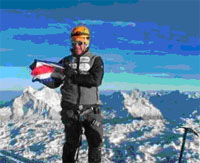 |
|---|
| Rojas Planting the Costa Rican Flag on Mount Everest |
 |
|---|
Mount Everest - 8853 Meters |
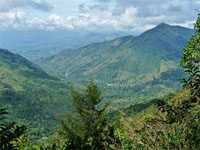 |
Mount Chíripo - 3820 Meters |
His name is Warner Rojas.
Rojas was a member of an assault group called the Jagged Globe Team. They started their ascent in April, stopping at four base camps before reaching the summit on May 24.
The magnitude of the Everest climb and the physical demands on the climbers is astounding. We have beautiful mountains in Costa Rica that also make for a daunting climb and I have friends that climbed Mt. Chiripo, the highest in Costa Rica. Afterwards, they had difficulty walking for a week.
But the Everest thing is different and much more dangerous.
Chiripo is 3,820 meters (12,530 ft). Everest, on the other hand is more than twice the height of Chiripo at 8,864 meters (29,100 ft). And need we point out that while things get rather cool at the top of Chiripo, the temperature is lethally cold at the top of Everest In January, the coldest month, summit temperature averages -36° C (-33° F) and can drop as low as -60° C (-76° F). In July, the warmest month, the average summit temperature is -19° C (-2° F).
Several times during their trek, the team was reminded of the dangers inherent in this kind of effort. One of their sherpa guides had to be air evacuated when he fell into a crevice and was badly injured. On the last day of the assault, only a few hundred meters from the top, the team came across the bodies of Chinese and Canadian climbers who had died only a week before. Then, a short time later they came across two more bodies of people that had been dead a few years.
When Rojas returned to his hometown of San Antonio de Escazú on Friday, June 8 he was treated to a hero's welcome. (Free gallo pinto and cheese tortillas for everybody amigo and bring on the vino de coyol!). An interesting aspect about Warner emerged from press reports: "Rojas doesn't’ drive. He rides the bus", said one report.. (Yeah, those Tico drivers can be dangerous, amigo)
Buen trabajo y felicidades, Señor amigo Rojas.
Harried Hookers
Prostitution is not illegal in Costa Rica, although acting as an agent for these services, i.e., pimping, is. I'm not sure I understand the nuances that distinguish the two in the eyes of the state, but that's the way it is here.
 |
|---|
Some of the Working Girls at the Key Largo Club |
 |
Police Talking With Customers on the Night of the Raid |
So one may wonder why a large contingent of police, including Fuerza Publica (National Police) and security forces of a least two ministries, recently descended on one of the best known "nightclubs" in San José, the Key Largo Club at the Hotel Del Rey. This place is frequented by a large number of freelance "working girls" day and night and has an international reputation among men, particularly norteamericanos (gringos and canucks).
The police sealed the exits detaining all the girls. Then they set up interview desks where the girls, including the female bartenders, were required to fill out detailed personal questionnaires and were interviewed by (female) police agents. Of course, as is normal or customary, many of the girls did not pass muster with regard to their visas. Many of these ladies come up from Colombia, some never bother to get a visa while others let it expire after 90 days without going to the border to renew it..
The result of all this police effort? One man with an outstanding warrant for aggravated robbery was detained and jailed. Twenty seven people, mostly women, were found to have inadequate documentation to prove they were in Costa Rica legally. This latter group was ordered to report on their own recognizance to Migración (Immigration Department), which means in Costa Rican tradition and practice, they were released.
So why go to all this trouble just to harass the hookers but not deport them. The answer was provided by some local press who pointed out that the police were accompanied on the raid by pink-shirted, body-armored volunteers from the Fundación Rahab, an organization that receives substantial anti-"human trafficking" grants from the U.S. State Department to rehabilitate former prostitutes (it occurs to me that they could use some of those funds right there in Washington).
So, apparently, the raid came just before the grants are to be renewed and supposedly demonstrates to U.S. officials the Tico efforts to reduce human trafficking. Year, right, whatever.
In a related article less that two weeks ago, Sala IV, the constitutional court. chastised the Ministerio de Securidad (Security Ministry - but you probably figured that out by yourself) for being too enthusiastic on a new raid similar to the Key Largo. Only this time the bar was a gay hangout called the Club Oh! The police did the same thing, i.e., locked in the patrons, ran questionnaires etc. but evidentially they were a bit abusive to the gay patrons, so the bar owner lodged a complaint that resulted in the court dressing down the ministry..
Oh! Dear.
New Airport
Ever since our hero started coming to Costa Rica in 2003, there has been talk of plans (read thoughts) to build a third international airport to complement the nation's major airports called Juan Santamaria in Alejuela province (central valley) and Liberia in Guanacaste (northwest). The idea is to take the pressure off these airports and provide more direct access to the central and south Pacific coast to support their development.
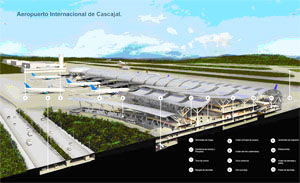 |
|---|
Artist's Drawing of Proposed New Airport at Cascajal de Orotina.
(You Need a Magnifying Glass to Read the Legend) |
As a former plant site location specialist for a major corporation (back then we just called it facilities planning), GG is following this project with interest. What I've heard recently leaves me asking more questions about the logic of it all.
The airport is now proposed to be built at Cascajal de Orotina, a town probably no more than 45 minutes by car from the existing national airport. This would be in the same province, Alejuela, as Juan Santamaria and a little farther west of San José.
Over the years I've heard at least two other possible locations proposed for this airport. One was in Quepos. We have a rather flat valley area here that already contains a small airport and the shore roads north and south of us (the Costanera Sur) have improved dramatically in recent years. Mind you I'm not pushing this location as I'm not crazy about the idea of hearing big fat jets crossing our valley and breaking the quiet tranquility we now enjoy.
Another suggestion was about half way between Quepos and Golfito. Golfito is a gateway town to the Osa peninsula and fairly remote to most areas in Costa Rica. It now takes about two and a half hours by car to reach Golfito from Quepos, and is, in turn, only about 45 minutes or so from the Panamanian border. Putting the new airport too far down the coast makes access to the central pacific coast more difficult. No amigo, logic would suggest siting the new airport somewhere in the Quepos/Dominical/Uvita strip.
But don't tell anyone, Cascajal is just fine by me. And don't get your gallo pinto all stuck together in anticipation of the construction of the new airport as the completion date isn't projected until 2026.
Nica Invasion Update
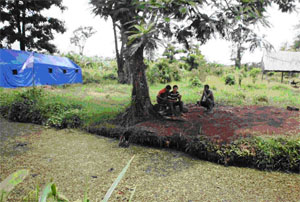 |
|---|
Camp Nica on the Isla Calero Time to Break Camp Chicos |
GGC has reported several times (particularly Editions 28, 29, 30, 31, 32) on the Nicaraguan invasion of a small part of northeastern Costa Rica that includes Isla Calero (Calero Island).
The Nicas continue to cut a new mouth to the San Juan river through Tico territory. The river used to be the border between the two countries in that area. The Ticos continue to ride their bicycles along the 100 mile road they built on the edge of the river west of Isla Calero in an attempt to discourage any further acquisitions of Tico river bank lands.
And the Nicas continue to use Isla Calero as a camp ground for youths (now they're pitching tents - see photo right) despite an order from the International court of Justice in the Hague that neither country should occupy the "disputed" land. What dispute amigos, the buggers just took the place without asking. Some of us, in personal matters, call that theft, and in international matters the term most commonly used is aggression.
Go home boys, your moms' miss you.
IBM Tech Center
IBM officially opened its new information technology center in the central valley outside of San José recently.
 |
|---|
The company says it plans to invest $300 million in Costa Rica over the next 10 years. This new facility will support the firm's cloud computing operations. The company said it plans to hire about 1,000 persons by 2014. (That's only about two years away amigos)
Now, I've been using computers since 1966, when the best ones took up the space of small buildings yet had less computing power than one of today's laptops, but I didn't know what "cloud" computing was until recently. I asked about the term to my daughter who happens to work for another computer firm that also offers cloud computing. She enlightened me that basically it's just buying computer time and the use of a wide variety of software on a rental basis. By logging into a center like the new IBM location from a remote terminal and paying for the service by day or by use. In the old days we called this kind of service time-sharing.
 |
|---|
American Free Zone, Heredia, C.R. |
I used a primitive form of this technique in the 1970's working on a planning project in Scotland with the computer work actually being done in Cleveland (this was pre-internet - I think maybe Taft was president). We connected over a telephone line by placing the phone headset onto a old fax-like receiver and typed on a machine that looked like an old typewriter. It sounds really primitive to me now but it worked and it worked well for what I was doing.
The new IBM facility is located in the American Free Zone in Heredia about 10 miles west of San José. The AFZ is a 30 hectare (50 acre) with full infrastructure in a commercial park that started in 1999 and houses other tech giants such as Hewlett Packard, DELL. Teradyne and a number of other tech firms including Intel's administrative offices for the region. Intel also has a major manufacturing plant nearby - see Microchips.
Welcome to Costa Rica, Big Blue. ¡Pura Vida!
Obamacare and Ex-Pats
So, let's suppose you happen to be an ex-pat living abroad that happens to be covered by your host country's health care program. Will that person have to pay a tax, er, excuse me... penalty if they don't buy U.S. insurance under Obamacare? The initial answer is probably not.
 |
|---|
Obamacare End of Life Counseling |
The law was reviewed by an advocacy group called American Citizens Abroad, who rendered this opinion: “Americans who are bona-fide residents overseas are not subject to Obamacare tax or penalties. However, the new Medicare tax in the Affordable Care Act (3.8 percent on incomes over $250,000) will be applicable.” GG worries not about exceeding that income threshold.
Our hero joined the Costa Rica "Caja" (pronounced "cah-hah)" or health system back in 2010 when a sudden change in the law (happens regularly here) made it compulsory to join the system in order to receive approval for a residency card. Two months later, after I had joined the Caja, the Ministry of Dubious Decisions reverted to their old practice and two of my friends who were pursuing their cédulas just behind me on the application time-line were shut out. Subsequently, I withdrew from Medicare as I can't use it here at all.
I wonder if some day they're going to try to make me enroll in Medicare again?
¡Salud!
One of the greatest and most prolific fruits grown in Costa Rica is the Mango. I wrote about them in some detail back in November 2011 in Mangomania.
 |
|---|
A Ripe Mango - Partially Processed |
 |
The Handy-Dandy MDN (Mango De-Nutter) |
When a friend from New Hampshire visited recently, he kindly left me with a gift. I call it a mango de-nutter and it helps to remove the large, oval shaped pit from the sweet flesh. Now one might be suspicious of a guy from the north offering a tool to process a tropical fruit. More likely I would have expected him to offer a maple syrup tap (maybe they'd work on a Coyol tree?).
The tool he gave me is pictured to the right. I call it a mango de-nutter for lack of a better name. Before getting my tool, I spent considerable time on the internet finding out how to process a mango into easily edible chunks or slices. I got instructions on using everybody's favorite rendering technique including using a sharp knife and a soup spoon.
Au contraire amigo; it needn't be that complicated or fraught with danger (sometimes I stabbed myself). Simply cut a half inch or so off the narrow end of the mango, position the cut end over the oval cutter as shown with the shape of the mango oriented like the blade and push it through. Voila, presto, you have the two sides of the mango ready for cubing as shown in the top picture. (I consider any flesh left on the nut as payment for my hard work and slurp it off with gusto).
Some tips on using the MDN:
(1) Always position the unit as shown in the picture, not on the reverse side as the opposite site of the blade is dull and you can make mango mush with enough force,
(2) best to work over a bowl to catch the considerable juices (incorporate into a smoothie),
(3) the tool works best on medium sized fruit but the pit will be too big to process on some of the larger fruit, (4) I place a pot holder over the uncut end to push the mango through and to avoid slicing my thumb into three pieces. The MDN is a great tool that makes mango processing much quicker and almost effortless. Thanks Chris.
Chief Golden Gringo Like Mango Tool, Amigo.
What's-in-a-Word
Henry
There's a new couple in the political news that cut a Kennedy-esk figure (John Kennedy and Jackie, that is, not the rest of them).
 |
|---|
Peñaand Wife Angelica |
That couple is the new President of Mexico, Enrique Peña Nieto and his television starlet wife Angelica Rivera. What grabbed my attention was his name.
Now, just about everybody knows that Enrique is Spanish for Henry. But are there English equivalents for Peña and Nieto? Why, yes there are, oh golden one. According to my handy-dandy Océano dictionary, a peña is crag, you know, a split in a large rock formation. (Perhaps we should adopt Rocky as Henry's nickname)
From living here I knew what his second name was; nieto is Spanish for grandchild, particularly grandson. So Señor Peña, in English, is actually Henry Crag Grandson. Sounds more melodic and romantic in Spanish don't you think?
Sorry Hank, I couldn't resist.
Ex-Pat
This is my second tour as an "ex-pat" or ex-patriot, the first having been a two and a half year stint in Brussels in the 1970's (my God, that's beginning to sound like the middle ages).
 |
|---|
"Expatacular" Maybe? |
I object to the term. I know it is intended to mean someone, usually a citizen of one country living in another country but to me it also sounds like one is an former patriot. Although I know "ex" can mean out of or from, it can also mean former and I'm not a former patriot.
Being perpetually irascible about unimportant things like this, I started conjuring up alternatives. Displaced patriot came to mind but that's almost as negative sounding. Guest resident is wooshy (wooshy is a term GG invented for just this purpose). "Expatacular" (see drawing right) seems cool but that's an adjective not a noun.
So then I hit upon the idea of having our Gentle Readers make a suggestion by way of a contest to come up with a better term. So, amigos, forward your suggestions (stick to the renaming of the ex-pat term and refrain from personal comments about the golden one please) to bob@bobnormand.com.. For those of you who like to work puzzles, you may want to enlist the aid of a web site like http://www.morewords.com/.
Price-Waterhouse will audit the ballots and winners will be announced in the September edition. First prize will be lunch at El Gran Escape. Second prize will be gallo pinto and scrambled eggs at my house. For budgetary reasons, there will not be a third prize (it's a tough economy, amigo).
¡Pura Vida!, ¡Solo Bueno!, ¡Tuanis, Mae!
Founder's Quotes
don Beto de Quepos, El Gringo Dorado Pura Vida! |
Be pithy but kind. I'm sensitive. |
|---|

